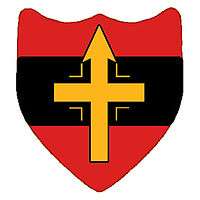Northern Command (India)
| Northern Command | |
|---|---|
|
Northern Command's insignia today | |
| Active |
1908-1947 1972 - Present |
| Country |
|
| Branch |
|
| Type | Command |
| Garrison/HQ | Udhampur |
| Commanders | |
| Current commander | Lt Gen Devraj Anbu |
The Northern Command is a Command of the Indian Army. It was originally formed as a formation of the British Indian Army in 1895, scrapped upon India's independence in 1947 and later reformed in 1972. Its present commander is Lt Gen Devraj Anbu.[1]
History
The Presidency armies were abolished with effect from 1 April 1895 when the three Presidency armies became the Indian Army.[2] The Indian Army was divided into four Commands (Bengal Command, Bombay Command, Madras Command and Punjab Command) each under a lieutenant general.[2]
In 1908, the four commands were merged into two Armies (Northern Army and Southern Army): this system persisted until 1920 when the arrangement reverted to four commands again (Eastern Command, Northern Command, Southern Command and Western Command).[2] Northern Command was re-formed again as North Western Army in April 1942 to guard the North West Frontier. It controlled the Kohat, Peshawar, Rawalpindi, Baluchistan and Waziristan Districts.[3] The former Western Command, was absorbed by the new North Western Army at that time.[4] The formation reverted to the title Northern Command in November 1945.[5] In 1947 Headquarters Northern Command became the new headquarters of the Pakistan Army. General Sir Frank Messervy continued to serve as Chief of Staff of the Pakistan Army from 1947 to 1948.[6]
Composition 1942-45
The composition was:
- 7th Indian Infantry Division, April 1942 to January 1943
- 84th Indian Infantry Brigade, May 1942 to October 1943
- 33rd Indian Infantry Brigade, July 1942 to December 1942
- 55th Indian Infantry Brigade, July 1942 to September 1942
- Risalpur Training Brigade (15 Nov 1940-April 1944) then redesignated 155th Indian Infantry Brigade, April 1944 to August 1945[3]
Commanders prior to Independence
Commanders included:[7]
General Officer Commanding-in-Chief Punjab Command
- 1895 - 1898 Major-General Sir William Lockhart
- 1898 - 1899 Major-General Sir Arthur Palmer
- 1899 - 1901 Major-General Sir Charles Egerton
- Oct 1901 - 1907 Lieutenant-General Sir Bindon Blood
General Officer Commanding-in-Chief Northern Army
- 1907 - Nov 1908 General Sir Alfred Gaselee
- Nov 1908 - Oct 1910 Lieutenant-General Sir Josceline Wodehouse
- Oct 1910 - Aug 1914 Lieutenant-General Sir James Willcocks
- Aug 1914 - Feb 1915 Lieutenant-General Sir Robert Scallon
- Feb 1915 - Apr 1915 General Sir John Nixon
- May 1916 - Nov 1920 General Sir Arthur Barrett
General Officer Commanding-in-Chief Northern Command
- Nov 1920 - Nov 1924 General Sir William Birdwood
- Nov 1924 - May 1926 General Sir Claud Jacob
- May 1926 - May 1930 General Sir Alexander Cobbe
- May 1930 - May 1934 General Sir Robert Cassels
- May 1934 - May 1936 General Sir Kenneth Wigram
- May 1936 - Jun 1940 General Sir John Coleridge
- Jun 1940 - Jan 1942 General Sir Alan Hartley
- Jan 1942 - Apr 1942 General Sir Cyril Noyes
General Officer Commanding-in-Chief North Western Army
- Apr 1942 - May 1943 General Sir Cyril Noyes
- May 1943 - Aug 1943 General Sir Edward Quinan
- Aug 1943 - May 1945 General Sir Henry Finnis
- Jun 1945 - Oct 1945 Major-General Cecil Toovey
- Oct 1945 - Nov 1945 General Sir Richard O'Connor
General Officer Commanding-in-Chief Northern Command
- Nov 1945 - Oct 1946 General Sir Richard O'Connor
- Oct 1946 - Aug 1947 Lieutenant-General Sir Frank Messervy
Re-raising
The government of India decided to raise a separate command to oversee operations in the northern borders with Pakistan and China. Lt Gen Premindra Singh Bhagat, VC was appointed as the first Army Commander in June 1972. Bhagat's main activities as Army Commander were the improvement of defences and the living and working condition of his troops.[8] Headquarters for the command was established at Udhampur, J&K.[9]
The XIV Corps (Leh), XV Corps (Srinagar) and XVI Corps (Nagrota) control the operational units in Northern Command. 71 Independent Sub Area is part of the Command. III Corps and its 57th Mountain Division were shifted into the command as a reserve for Operation Parakram in 2001-2002.[9]
References
- ↑ "Devraj Anbu is Northern Army Commander". 10 November 2016. Retrieved 19 November 2016.
- 1 2 3 "Northern Army". Retrieved 4 January 2010.
- 1 2 "North Western Army". Order of Battle. Retrieved 2009-10-14.
- ↑ "British Military History". British Military History. Retrieved 2013-06-01.
- ↑ Major General Cecil Watton Toovey CB, CBE, MC
- ↑ Ammentorp, Steen. "Generals of World War II". Retrieved 2 June 2013.
- ↑ Army Commands
- ↑ Singh, V.K. Leadership in the Indian army: biographies of twelve soldiers (Illustrated ed.). New Delhi: Sage. p. 417. ISBN 978-0-7619-3322-9. Retrieved 10 August 2010.
- 1 2 Renaldi and Rikhye 2011, p. 21
Sources
- Rinaldi, Richard; Rikhye, Ravi (2011). Indian Army Order of Battle. General Data. ISBN 978-0982054178.

